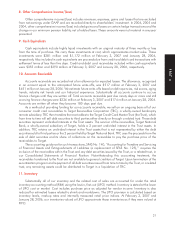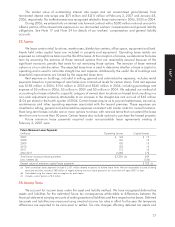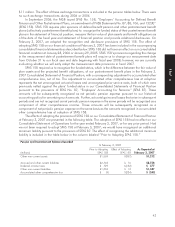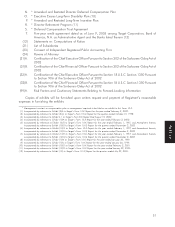Target 2006 Annual Report Download - page 59
Download and view the complete annual report
Please find page 59 of the 2006 Target annual report below. You can navigate through the pages in the report by either clicking on the pages listed below, or by using the keyword search tool below to find specific information within the annual report.
date. The assumptions disclosed below represent a weighted average of the assumptions used for all of our
stock option grants throughout the year.
Valuation of Share-Based Compensation
2006 2005 2004
Stock option valuation assumptions:
Dividend yield 0.8% 0.7% 0.7%
Volatility 23% 27% 22%
Risk-free interest rate 4.7% 4.4% 3.8%
Expected life in years 5.5 5.5 5.5
Grant date weighted average fair value $16.52 $16.85 $13.10
Performance share units grant date weighted average fair value $49.98 $53.96 $49.43
Restricted stock units grant date weighted average fair value $57.60 ——
Compensation expense recognized in Statements of
Operations (millions) $99 $93 $60
Related income tax benefit (millions) $39 $37 $23
Compensation realized by team members upon option
exercises (millions) $ 142 $ 180 $ 201
Related income tax benefit (millions) $56 $71 $77
As of February 3, 2007, there was $116 million of total unrecognized compensation expense related
to nonvested stock options. That cost is expected to be recognized over a weighted average period of
1.5 years. The weighted average remaining life of currently exercisable options is 4.8 years, while total
outstanding options have a weighted average remaining life of 6.3 years.
Holders of performance share units will receive shares of our common stock if we meet certain EPS and
revenue growth targets and the holders also satisfy service-based vesting requirements. Compensation
expense associated with outstanding performance share units is recorded over the life of the awards. The
amount of expense recorded each period is dependent upon our estimate of the number of shares that will
ultimately be issued and, for some awards, the current Target common stock price. Future compensation
expense for currently outstanding awards could range from a credit of $76 million for previously recognized
amounts up to a maximum of approximately $24 million of expense assuming full payout under all
outstanding awards.
Total unrecognized compensation expense related to restricted stock unit awards was $12 million as of
February 3, 2007.
27. Defined Contribution Plans
Team members who meet certain eligibility requirements can participate in a defined contribution
401(k) plan by investing up to 80 percent of their compensation, as limited by statute or regulation.
Generally, we match 100 percent of each team member’s contribution up to 5 percent of total
compensation. Our contribution to the plan is initially invested in Target common stock. These amounts are
free to be diversified by the team member immediately.
In addition, we maintain nonqualified, unfunded deferred compensation plans for approximately
4,900 current and retired team members whose participation in our 401(k) plan is limited by statute or
regulation. These team members choose from a menu of crediting rate alternatives that are the same as the
investment choices in our 401(k) plan, including Target common stock. Through the end of 2005, we
credited an additional 2 percent per year to the accounts of all active participants, in part to recognize the
risks inherent to their participation in a plan of this nature. Effective in 2006, the additional 2 percent per
year was credited only to the accounts of active participants who were not executive officers. We also
maintain a nonqualified, unfunded deferred compensation plan that was frozen during 1996, covering 15
current and 49 retired participants. In this plan deferred compensation earns returns tied to market levels of
interest rates plus an additional 6 percent return, with a minimum of 12 percent and a maximum of
20 percent, as determined by the plan’s terms.
We control some of our risk of offering the nonqualified plans through investing in vehicles, including
prepaid forward contracts in our own common stock, that offset a substantial portion of our economic
41
PART II
























